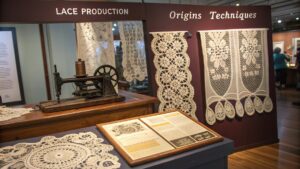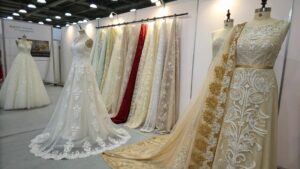Many wholesale lace fabric buyers ask me this question, but most suppliers give you half-truths. The real answer requires understanding what true customization means in lace manufacturing.
Yes, we create fully custom lace designs with complete exclusivity protection. Our process combines original design capability, technical manufacturing flexibility, and collaborative development to deliver genuine custom solutions that protect your brand’s uniqueness.
After working with hundreds of fashion designers and manufacturers over the years, I know that most people think custom lace means tweaking existing patterns. This approach fails to deliver the exclusivity that discerning brands need. Real custom lace development requires a completely different mindset and manufacturing approach.
What makes custom lace truly exclusive?
Most lace fabric suppliers claim they offer custom work, but they simply modify existing designs. This creates problems for brands seeking genuine exclusivity.
True custom lace exclusivity comes from original design creation, copyright protection, and manufacturing processes that ensure no other client receives your specific pattern. This protects your brand investment and market positioning.
Original Design Foundation
At Marry Lace, we maintain over 20,000 copyrighted designs in our database. This extensive library serves as our creative foundation, not a source for copying. Our design team creates 1,000+ completely new patterns annually, which means we understand the creative process from concept to production reality.
When you approach us for custom work, we start with a blank canvas. Our designers study your brand aesthetic, target market, and functional requirements. We then develop initial concepts that reflect your vision rather than adapting something that already exists. This approach ensures your custom lace1 becomes a true brand differentiator.
Legal Protection and Exclusivity
Many manufacturers cannot offer true exclusivity because they lack proper design protection2 systems. We register all custom designs under copyright protection, which means your investment remains secure. No other client can access your specific pattern, colorway combination, or technical specifications.
Our design process includes formal exclusivity agreements that protect your intellectual property rights. This legal framework gives you confidence that your custom lace1 investment will maintain its competitive advantage in the marketplace.
Quality Control in Custom Production
Custom lace requires different quality standards than standard wholesale lace fabric production. We implement specialized quality control procedures for custom orders, including individual batch tracking, color consistency verification, and pattern accuracy checks. Our facilities in China and Turkey both maintain these enhanced standards for custom work.
How does the collaborative design process work?
Many suppliers treat custom orders as one-way transactions where clients submit specifications and wait for results. This approach often leads to disappointing outcomes and wasted time.
Effective custom lace development requires ongoing collaboration between client and manufacturer. We work directly with your design team through structured phases that ensure technical feasibility while maintaining creative vision.
Understanding Functional Requirements
The collaborative process starts with understanding how your custom lace will be used. Wedding dress designers need different characteristics than lingerie manufacturers or home decor specialists. We analyze the functional requirements first, then build the aesthetic elements around these technical needs.
Our technical team examines factors like weight requirements, drape characteristics, stretch properties, and durability needs. For bridal lace wholesale applications, we focus on structure and elegance. For lingerie applications, comfort and flexibility become priorities. This functional analysis guides every design decision.
Sample Development and Refinement
We provide detailed samples at multiple stages of development. Initial concept samples show basic pattern structure and scale. Refined samples incorporate color development and technical specifications. Final approval samples match exact production parameters, including thread composition and finishing details.
This multi-stage sampling process prevents costly mistakes and ensures final production meets expectations. We maintain strict dye lot consistency throughout sampling and production, which I know creates challenges for many suppliers but remains essential for professional results.
Technical Communication and Documentation
Clear communication prevents misunderstandings that can ruin custom projects. We provide detailed technical specifications for every custom design, including thread counts, pattern dimensions, color formulations, and finishing requirements. Our documentation system ensures production consistency across different manufacturing runs.
Why is technical flexibility crucial for custom orders?
Standard production lines work efficiently with predetermined specifications, but custom work requires manufacturing adaptability that many suppliers cannot provide.
Technical flexibility allows us to accommodate unusual thread compositions, non-standard colorways, modified pattern scales, and specialized finishing requirements. This capability separates genuine custom manufacturing from basic pattern modification services.
Manufacturing Adaptability
Our production facilities in both China and Turkey can adapt to custom requirements without disrupting standard operations. We maintain specialized equipment for custom work, including variable-speed embroidery machines that can accommodate different thread types and tension requirements.
For beaded lace collection custom work, we adjust bead application techniques based on your specific aesthetic and functional needs. Our 3D floral embellishment capabilities include custom flower shapes and arrangements that match your design vision.
Color Development and Matching
Custom color development requires sophisticated dye management systems that many textile wholesaler lace suppliers lack. We maintain color matching capabilities that can reproduce specific Pantone colors, match fabric swatches, or develop completely new colorways based on your specifications.
Our custom color development process includes multiple approval stages and maintains consistency across production batches. We test colorfastness and compatibility with different finishing processes to ensure your custom colors perform reliably in final applications.
MOQ Flexibility for Custom Work
Standard wholesale requires high minimum order quantities, but custom work often needs smaller initial quantities for market testing. We offer flexible MOQs for custom lace fabric orders, understanding that exclusivity often means smaller initial volumes.
This flexibility extends to our wholesale lace edging and rhinestone applications custom work. You can develop custom patterns without committing to massive inventories before proving market demand.
Conclusion
Custom lace manufacturing requires original design capability, collaborative development processes, and technical manufacturing flexibility that goes beyond simple pattern modifications.







